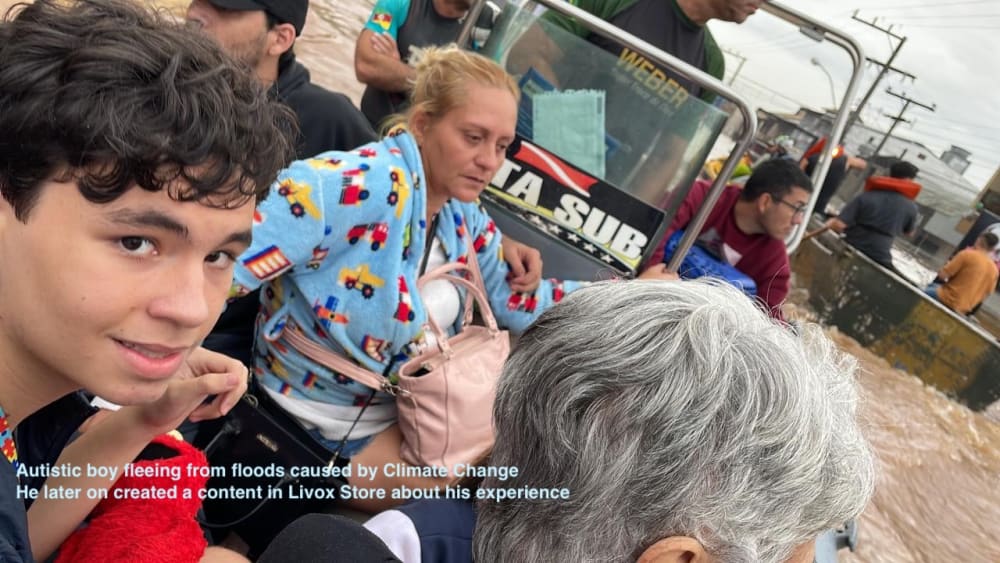Across the globe, people with disabilities—particularly those in underserved and climate-stricken regions—are too often excluded from the mainstream of technological innovation. When catastrophic floods struck southern Brazil, children with disabilities faced obstacles at every turn: inaccessible evacuation routes, inadequate rescue protocols, and little support to share their experiences. Livox challenges this injustice by using advanced AI automation to let these marginalized youths—who were once passive observers—become the next generation of climate activists and innovators.
A Real-World Example: Pedro (photo shared in our application)
One striking case is Pedro, a non-verbal autistic boy whose photo fleeing the floods in a small boat has become an emblem of the crisis. Before generative AI, it was nearly impossible for a child like Pedro to produce and share meaningful content due to his communication barriers. Yet after being evacuated to safety, Pedro used Livox to create original storyboards and informational materials about floods, biodiversity, and inclusion. This newfound ability isn’t just about self-expression; it mobilizes community awareness and fosters advocacy, transforming a child who was once seen as a silent victim into a compelling voice for change.
Problem & Benefits
We specifically address the intersection of disability and climate disasters. Typically, children like Pedro, who cannot easily speak or write, remain invisible in public discourse. Livox’s automated tools—powered by AI (Large Language Models) —allow them to create interactive boards with images, text, and speech outputs, even if they have limited motor skills. This shift improves individual quality of life and drives community-wide resilience by sharing firsthand experiences and crowd-sourced solutions.
How It Works (Robotics & Automation Aspect)
Although Livox is a software platform rather than a physical robot, it embodies the same principles of automation. Users type or select prompts (e.g.: "Create a Flood Rescue Strategy"), and our AI automatically generates content, eliminating the need for labor-intensive manual assembly. Interactive visuals, symbol-based communication, and voice output further support those who are nonverbal or have cognitive differences.
Novelty & Application
By focusing on underrepresented voices, we go beyond standard assistive communication. Our platform enables youth to co-create disaster preparedness materials, exchange cultural and environmental knowledge, and even propose policy recommendations. As climate emergencies—from floods in Brazil to hurricanes in the United States—grow in frequency, Livox has global scalability.
Market & Production
Livox licenses are sold to governments, schools, and nonprofits, with annual renewals, support, and training. Cloud-based distribution keeps production costs low while reaching vast populations. The need is immense, as laws mandating disability inclusivity are often underfunded and poorly enforced. Our approach gives local authorities a tangible tool to meet legal obligations and truly empower young changemakers.
Feasibility & Future
Livox is already in use by hundreds of schools, with a decade-long renewal track record in several major Brazilian cities. We envision discovering the “next Greta Thunbergs” among these children—turning a historically silenced demographic into influential leaders who redefine both disability rights and climate activism on a global stage.
Like this entry?
-
About the Entrant
- Name:Carlos Pereira
- Type of entry:individual
- Software used for this entry:Android
- Patent status:none

